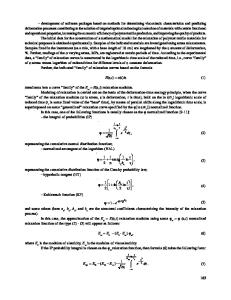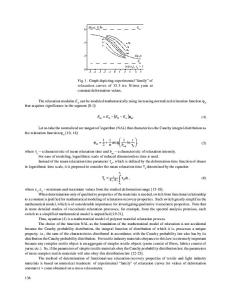Mathematical Modelling and System Analysis of Viscoelastic-Plastic Properties of Nautical Polymer Ropes
- PDF / 141,342 Bytes
- 4 Pages / 594 x 792 pts Page_size
- 72 Downloads / 276 Views
Fibre Chemistry, Vol. 52, No. 3, September, 2020 (Russian Original No. 3, May-June, 2020)
MATHEMATICAL MODELLING AND SYSTEM ANALYSIS OF VISCOELASTIC-PLASTIC PROPERTIES OF NAUTICAL POLYMER ROPES I.M. Egorov, A.G. Makarov, M.A. Egorova, and N.V. Pereborova
UDC 539.434: 677.494
Methods for mathematical modeling and system analysis of the viscoelastic-plastic properties of nautical polymer ropes are described. Recommendations for the design of new rope prototypes are provided together with a specification of the functional properties.
The viscoelastic-plastic properties of nautical polymer ropes are determined by two fundamental processes: relaxation (stress relaxation) and deformation (creep). Mathematical modeling of the relaxation processes of nautical polymer ropes is based on an approximation of the Eεt generalized relaxation modulus curve by the ϕεt normalized function based on the hyperbolic tangent [1-3]: Eεt = E0 − ( E0 − E∞ )ϕεt ,
(1)
⎛ Aε t 1⎡ ln ⎢1 + th⎜⎜ τε 2 ⎢⎣ ⎝ 2
⎞⎤ ⎟⎥ , (2) ⎟ ⎠⎥⎦ where E0 is the elasticity modulus; E∞ is the asymptotic modulus of viscoelasticity; Aε is the structural relaxation intensity parameter; τε is the relaxation time determining half of the relaxation process during the ε deformation). Similarly, mathematical modeling of the deformation processes of nautical polymer ropes is based on an ϕ εt =
approximation of the Dσt generalized ductility curve by the ϕσt normalized function based on the hyperbolic tangent [4-6]:
Dσt = D0 − ( D∞ − D0 )ϕσt ,
(3)
⎛ Aσ t ⎞⎤ 1⎡ ln ⎟⎟⎥ , ⎢1 + th⎜⎜ 2 ⎣⎢ τ σ ⎠⎦⎥ ⎝ 2
(4)
ϕσt =
where D0 is the initial elastic ductility; D∞ is the asymptotic equilibrium ductility; Aσ is the structural-deformation intensity parameter; τσ is the deformation time determining half of the deformation process under a σ stress). The choice of the normalized function hyperbolic tangent as the basis for mathematical modeling of relaxation and deformation processes of polymer textile materials is not accidental, since this function, firstly, is elementary, thus simplifying any analytical transformations, and secondly, its graph is quite close to that of the integral density of the normal distribution [7-9]. In order to verify the adequacy of the developed mathematical models of relaxation and deformation processes, the calculated relaxation and ductility modulus values can be compared with data derived from a short-term experiment. Studies have shown that the relative deviations of the calculated values of the relaxation modulus and ductility from the St. Petersburg State University of Industrial Technologies and Design. E-mail: [email protected] Translated from Khimicheskie Volokna, No. 3, pp. 48-51, May – June, 2020.
0015-0541/20/5203-0179© 2020 Springer Science+Business Media LLC
179
experimental values do not exceed 8%, representing a good indicator for technical calculations in solving problems of this level. Another advantage of the mathematical models for relaxation (1), (2) and deformation (3), (4) processes consists in the smallest number of parameters hav
Data Loading...











